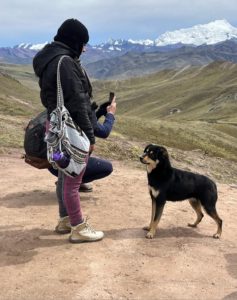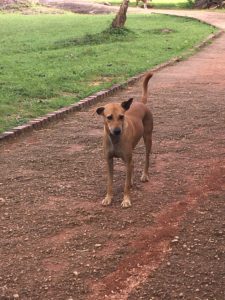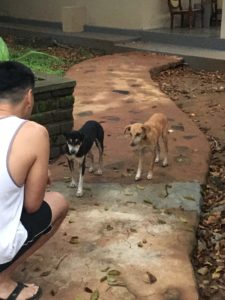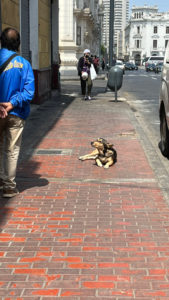
Michael Baugh CDBC CPDT-KSA
Here’s what I’ve learned observing dogs in more than 20 countries around the world. The first is that dogs always live with or near people. This is not a species that lives independently among its own kind. While dogs may kill the occasional vermin, they do not hunt in organized packs. They eat our food, so-called human food. Dogs scavenge and negotiate food from us (i.e beg). They depend on us more than they depend on each other. They are inextricably attached to our world, connected to people. Wherever you find humans (and really, we live everywhere) you will find dogs. No humans, no dogs.
Here’s what else I have learned. Despite the universal similarity of being cohabitants with humans, dogs live very differently in other parts of the world. North American Dogs’ lives are anomalous. They live in our homes, on leashes, vetted, crated, dog park bound, burdened with our emotional baggage, handled and touched at every corner and in every boutique dog shoppe and every daycare franchise on the continent. This is without a doubt unusual. It is not how most dogs on the planet live.

I’ve learned a lot about dogs just watching them. Here are some of my field notes in no particular order.
Dogs Roam. In Asia, Central America, and South America especially, dogs work the streets. Even dogs who have homes and wear collars with tags spend their days wandering off-leash.
Dogs seek food from us. This is true on each of the five continents I’ve visited so far. Dogs are food-seekers. They are not after ribbons or praise or attention or even our touch. They spend their waking hours working for food. Mostly they scavenge our garbage. Often they experiment with behavior so that humans give them food from their pockets, or their backpacks, or their plates – human food (no one in Sri Lanka is carrying a bag of Zukes dog treats).

They’ve evolved to affect our emotions. This was one of the coolest realizations for me. Even the scrappiest dogs on the dustiest streets have “the look.” Dogs retain a juvenile looking face into adulthood, more-so than other species. And, everywhere I’ve encountered dogs they’d all adopted facial expressions that accentuate their puppy features, endearing, cute. When we see it many of us will get a rush of hormones, the same warm feeling that bonds us to our own dogs. I don’t want to ruin this romantic notion. But, at the same time, I will tell you this face most often shows up when dogs are seeking food from us. I once ate at an outdoor restaurant in rural Costa Rica and four dogs where sitting politely about six feet from our table, each of them giving us “the look.” When we broke eye contact and continued our meal, they moved on to the next table, a respectable distance away, to try their elegantly evolved behavior on some other patrons. I will add, these dogs looked very well-fed.
They play with each other. This is less common in mature dogs. I saw it frequently with puppies and young adults.
They rarely fight. It’s usually over food and it is infrequent and usually non injurious.
Dogs use a lot of space when communicating. It’s quite rare to see dogs end up in tight spots together. They social distance. Very often I’ve seen dogs communicating with body language and facial expressions at 30 feet or more. It often appears to be about one dog asking the other may I pass or are you safe. Very frequently it looks like I see you, dude, come on through. Occasionally it’s about one dog denying access to a particular area. I remember a food court on a bluff outside a tourist spot in Colombia. Four dogs lived there. A brown short-haired female dog about 50 pounds started to wander up the path to the parking lot and food stalls. One of the four dogs in residence, a large male, stood tall and stiff and gave her a hard look. She stopped and then hedged her bet, taking a step forward. That’s when big male bolted down the path towards her full speed. The once optimistic female tucked her tail and ran. They never got closer than 15 feet from each other. No one got hurt.
Dogs walk faster than us. We really need to pick up the pace to match their stride. Also, I’ve never seen a dog on the streets anywhere in the world run for any significant amount of time.

Dogs are not naturally inclined to accept our approach and touch. Many will approach humans. Those individual dogs will often hang out for a little petting. A puppy outside a temple in Thailand stayed long enough to play with me (I had the sharp little tooth marks to show for it). But, generally speaking, dogs don’t want us reaching for them and folks elsewhere in the world don’t assume the right to touch every dog they see. Most dogs will keep a few feet between themselves and passing humans. As a result, I’ve never seen a dog behave aggressively towards a human in any other country. I’m not saying it doesn’t happen. But, I suspect it is not as common as it is here.
They stop at intersections without assistance from people. I’ve seen some stop when the cross walk signal is red and then go when it turns green, though this probably has more to do with learning to follow the mass of people than the signal itself.

Dogs sleep a lot. Some sleep as much as 14 hours a day.
There aren’t many old street dogs. I don’t want to sugar coat the experience of dogs in other parts of the world. Do they seem happy? Yeah, I think so. And I also think dogs on the streets have hard lives. It’s a young dog’s game, street life. I have only seen one that looked older than maybe 5 or 6-years old. There was a 10 year old dog at the food court I mentioned above, but he belonged to a family there.
People love dogs. Just like you and me, people around the world love dogs. Many dogs have homes and warm beds, even ones who roam the streets all day. Letting the dogs wander freely appears to be how their humans express love (I do not recommend we do that here). People have small dogs they carry in backpacks or in the baskets of their scooters. Others have large dogs. Most dogs are a natural mix of genes, some are specific breeds. The range is similar to what we see here. People around the world laugh at their dogs’ silly antics. Also like you and me, they sometimes get frustrated calling their dog in at the end of the day (I saw a puppy in Peru who seemed to insist he needed just a bit more time romping with a friend on the cobble stone streets of Cuzco.) People worry after their dogs, keep photos of them, and mourn them when they are gone.
People and dogs. We’ve been together for as long as there has been history and probably longer. We’ve co-evolved. We are interconnected. Dogs as a species, most certainly, would not go on without us. They’d evolve into something else or disappear. Humans as a species would likely survive without dogs. But, it wouldn’t be the same. People around the world know that, too. It wouldn’t be the same at all.
Michael Baugh teaches dog behavior in Houston TX. He specializes in aggressive dog training.
